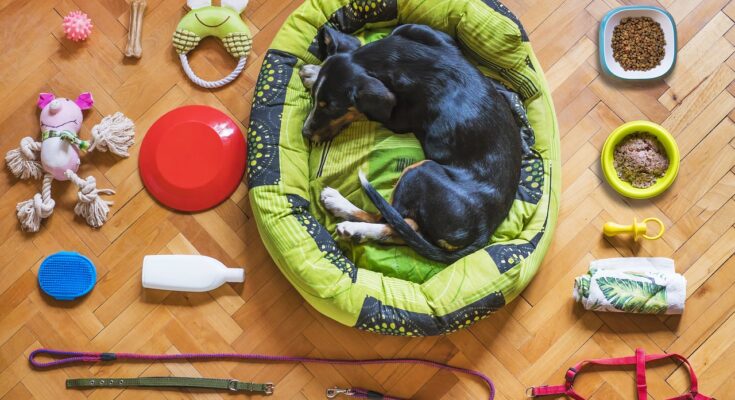Have you ever wondered what goes into creating dog-friendly products?
It’s not just about making something that looks cute or tastes good to your furry friend. Developing dog-friendly products requires a deep understanding of canine behaviour and physiology, as well as a commitment to safety, effectiveness, and sustainability.
In this article, we’ll explore the science behind developing dog-friendly products. From assessing product safety and effectiveness to incorporating behavioural science in product design, we’ll delve into the intricate details of creating products that promote health and wellness for our four-legged companions.
We’ll also discuss the importance of collaboration with veterinarians and experts, and how building trust with pet owners is key to developing products that truly make a difference in the lives of our beloved dogs.
So let’s dive in and discover what it takes to create the perfect product for our furry friends!
Understanding Canine Behavior and Physiology
Understanding how dogs behave and function physiologically is crucial for creating products that cater to their needs. Canine cognition plays a huge role in how dogs interact with their environment. For example, their ability to perceive colour is limited compared to humans, and they rely more on their sense of smell and hearing. This means that products designed for dogs should consider their sensory perception, such as using scents or sounds that dogs can easily recognize.
Furthermore, understanding canine behaviour is essential for creating products that cater to their needs. Dogs have unique behaviours that can vary depending on their breed or personality. For instance, some dogs may have a tendency to chew on furniture or shoes, which is why chew toys are popular among dog owners. By designing products that align with their natural behaviours, dogs are more likely to enjoy using them.
As a result, it’s essential to stay up-to-date with the latest research on canine behaviour to create products that are both functional and enjoyable for dogs.
Assessing Product Safety and Effectiveness

As you navigate the treacherous waters of product development, you must ensure that your creation is a sturdy vessel, capable of weathering any storm and safely transporting your furry passengers to their destination.
One crucial step in this process is product testing. This involves subjecting your product to a battery of tests to ensure that it is safe and effective for use by dogs.
Product testing can take many forms, including laboratory testing and field trials. In laboratory testing, scientists will evaluate the safety and efficacy of your product under controlled conditions.
Field trials, on the other hand, involve putting your product in the hands of real dog owners and collecting feedback on its performance. Both forms of testing are important in ensuring that your product is safe and effective for use by dogs.
Additionally, gathering consumer feedback is crucial in identifying any potential issues or areas for improvement in your product. By taking these steps to assess product safety and effectiveness, you can ensure that your creation is a trusted and reliable tool for dog owners everywhere.
Incorporating Behavioral Science into Product Design
By incorporating insights from how dogs behave and interact with their environment, designers can create products that seamlessly integrate into a dog’s daily life.
This is where user research and market analysis come in. User research involves observing and studying how dogs interact with products, while market analysis helps designers understand the current trends and demands in the market. With these two components, designers can determine what features and functions are needed to make a product truly dog-friendly.
One important aspect of incorporating behavioural science in product design is understanding a dog’s natural tendencies. For example, dogs have a natural instinct to chew, so a chew toy that mimics the texture and feel of something they would naturally chew on is more likely to be successful.
Additionally, dogs are social animals and thrive on interaction with their owners, so products that encourage play and bonding, such as interactive puzzles or fetch toys, can enhance the overall experience for both the dog and the owner. By taking these insights into consideration, designers can create products that not only meet the functional needs of dogs but also enhance their overall well-being and happiness.
Creating Products that Promote Health and Wellness
Let’s dive into how we can design pet products that promote a happy and healthy lifestyle for our furry friends. One crucial aspect to consider when creating such products is the nutrition requirements of dogs. It’s essential to develop food products that are rich in protein, vitamins, and minerals. This can help maintain a healthy weight, strengthen muscles, and boost the immune system. Additionally, pet food should be free from harmful additives and preservatives that can cause health issues in dogs.
With the help of veterinary professionals and animal nutritionists, pet food companies can formulate balanced diets that cater to the specific needs of different breeds and ages. Another factor to consider is the exercise needs of dogs. Exercise is vital for maintaining a healthy weight, reducing anxiety, and promoting mental and physical stimulation.
Companies can develop toys that encourage physical activity, such as balls, frisbees, and ropes. Moreover, pet owners can benefit from products that monitor their dog’s physical activity levels and provide insights into how much exercise they need. By keeping dogs active and engaged, owners can help prevent obesity, which can lead to a host of health problems in dogs.
Overall, designing products that cater to the nutrition and exercise needs of dogs is crucial for promoting a happy and healthy lifestyle for our furry companions.
Addressing Sustainability and Environmental Concerns
You can make a positive impact on the environment by choosing sustainable pet products that are made with eco-friendly materials. Many companies today are taking steps to reduce their carbon footprint by using renewable resources, recycled materials, and biodegradable components in their pet products. By selecting these items, you can reduce your own carbon footprint while also providing your furry friend with a safe and healthy product.

Eco-friendly materials can include everything from bamboo fibres to recycled plastics. When selecting pet products, look for labels that state the materials used are sustainable and environmentally friendly. Additionally, consider products that are made locally or regionally, as this reduces the amount of energy needed to transport them.
By making conscious choices about the products you purchase for your pets, you can help reduce waste and promote a healthier planet for all.
Collaboration with Veterinarians and Experts
Now that you have a better understanding of the sustainability practices that go into developing dog-friendly products, it’s time to delve into another important aspect of the process: collaboration with veterinarians and experts.
When it comes to creating products that are optimal for our furry friends, research methodologies and clinical trials are key in ensuring the safety and effectiveness of each item. By working closely with veterinary professionals, companies are able to develop products that address specific health concerns in dogs, such as joint pain or anxiety.
These experts provide valuable insight into the needs of our pets and can help identify any potential issues that may arise from using certain ingredients or materials. Additionally, clinical trials allow for a thorough examination of a product’s impact on dogs, from its overall effectiveness to any potential side effects.
By conducting these trials, companies can ensure that their products are both safe and beneficial for dogs of all breeds and sizes. In short, collaboration with veterinarians and experts is integral to the development of dog-friendly products.
Through the use of research methodologies and clinical trials, companies can create products that are not only environmentally sustainable but also effective in promoting the health and well-being of our furry friends.
Building Trust with Pet Owners
Creating products that pet owners can trust is essential for companies in the pet industry to build strong relationships with their customers. One way to achieve this is through pet owner education. Companies can provide information on their products and the ingredients used, as well as tips on proper usage and care. This helps pet owners understand the value of the product and how it benefits their furry friends.
By being transparent about their products and providing educational resources, companies can establish trust with pet owners and ensure their products are being used correctly. Brand transparency is another important aspect of building trust with pet owners. This means being open and honest about the company’s practices, including sourcing ingredients, manufacturing processes, and safety measures.
By showing that they have nothing to hide, companies can instil confidence in their products and reassure pet owners that they are making a responsible choice by purchasing them. Additionally, companies can engage with pet owners through social media and other platforms, responding to questions and concerns, and showing that they care about the well-being of pets.
By prioritizing transparency and communication, companies can establish a loyal customer base and ensure that their products are trusted and valued by pet owners.
Frequently Asked Questions
How do you determine the appropriate size of a dog toy for different breeds and sizes of dogs?
So, you want to design dog toys that cater to different breeds and sizes of dogs? Well, first things first, make sure you have a measuring tape handy.
Breeds vs. sizes can be a tricky thing to navigate, but with the right measuring techniques, you can ensure your toys fit all furry friends.
It’s also important to consider toy preferences. Do you have a chewer or a fetcher on your hands?
Designing for special needs, senior dogs, and disabilities is also crucial.
Don’t forget about those dogs who need a little extra love and attention.
So, get ready to roll up your sleeves and dive into the world of dog toy design!
What are the most common allergens in dog food, and how can they be avoided in product development?
When it comes to choosing dog food, it’s important to be aware of common allergens that can cause your furry friend discomfort.
Some common allergens in dog food include beef, dairy, wheat, and chicken.
When developing dog-friendly products, it’s important to consider ingredient alternatives to these common allergens. For example, you could use lamb or fish instead of beef, or quinoa or sweet potato instead of wheat.
It’s also important to consider the nutritional value of the ingredients and how they meet different dietary needs.
By being mindful of these factors, you can create products that are not only delicious for your pup, but also safe and healthy.
Can certain scents or materials in products cause anxiety or discomfort for dogs?
When choosing commercial dog products, it’s important to consider the effects of scent and material on dogs’ reactions. Certain scents or materials can cause anxiety or discomfort for dogs, which can be detrimental to their well-being.
Additionally, the perception of colour and texture in dogs can play a role in their overall experience with a product. That’s why it’s crucial for companies to prioritize user testing in product development to ensure the safety of commercial dog products.
By understanding the importance of these factors and conducting thorough testing, companies can create truly dog-friendly products that meet the needs of our furry friends.
How do you balance the need for durability and safety in dog toys?
When it comes to designing dog toys, it’s important to balance safety and fun. After all, the last thing you want is for your furry friend to injure themselves while playing with a toy.
To achieve this balance, toy manufacturers focus on creating designs that are both durable and safe. This means using materials that can withstand the rough play of dogs, while also avoiding any potential hazards like small parts that could be easily ingested.
A lot of thought and testing goes into the construction of toys to ensure that they can withstand the wear and tear of extended play. Ultimately, designing for play and longevity requires a deep understanding of the needs and behaviours of dogs, as well as a commitment to creating toys that will keep them happy and safe for years to come.
What steps are taken to ensure that dog-friendly products are ethically and responsibly sourced and manufactured?
When it comes to developing dog-friendly products, eco-friendly sourcing and ethical manufacturing are crucial factors to consider.
Ethical manufacturing ensures that workers involved in the production process are treated fairly and work in safe conditions.
Meanwhile, eco-friendly sourcing means that materials used in the products are obtained sustainably, without causing harm to the environment.
Companies can achieve these goals by partnering with suppliers who share their values, conducting regular audits, and being transparent about their sourcing and manufacturing practices.
By prioritizing eco-friendly sourcing and ethical manufacturing, companies can create dog products that not only benefit our furry friends but also contribute to a healthier planet and a more just society.
Conclusion
Now that you’ve delved into the science behind developing dog-friendly products, you have a greater appreciation for the intricacies involved in creating products that are not only safe and effective but also promote the health and wellness of our furry companions.
It takes a deep understanding of canine behaviour and physiology, as well as a commitment to addressing sustainability and environmental concerns, to create products that truly make a positive impact on our pets’ lives.
The collaboration between manufacturers, veterinarians, and experts is crucial to ensure that products are thoroughly assessed and designed with the utmost care and attention to detail. Building trust with pet owners is also key, as they rely on these products to provide the best possible care for their beloved pets.
By incorporating behavioural science in product design, manufacturers can create products that not only meet the needs of dogs but also enhance the bond between dogs and their owners.
With all these factors in mind, it’s clear that developing dog-friendly products is both an art and a science, requiring a balance of creativity and expertise to achieve the best possible outcomes.




